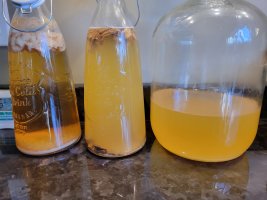dchulleman
New Member
- Joined
- Mar 9, 2023
- Messages
- 3
- Reaction score
- 1
I'll start by admitting I'm very new to this whole business and rushed into it without doing much research. What got me interested in this at all was some random youtube video so I'm very green when it comes to fermentation and mead making.
On the 15th of Febuary I started fermenting my first batch of mead, it was 1.6 kg of honey to 4 gallons with a starting SG of 1.132.
I used kveik ale yeast and went off the data sheet that said that around 7 days of fermenting at 77 degrees the fermentation would be done.
Here's where I think I messed up, I racked on Feb 23 without even stopping to look for signs of finished fermentation. I measured an SG of 1.083 and realized I was way to early. I split the mead into 3 separate containers.
In these 3 containers I decided to try and be fancy and placed, smoked oak chips in one, diced up strawberries in another and left one plain.
Now as of writing this on March 9 and having read into it a little more, I'm worried I've stalled the yeast.
All three containers are still bubbling but are having very different results (at least visually).
The strawberry mead looks great, it's cleared up quite a bit and has started to take on a nice flavour, the other two taste fine but are super cloudy, they also seem to be much sweeter (leading me to think they haven't fermented nearly as much).
I'm sort of at a loss as to what to do here, should I rack again? Should I add more yeast to the cloudy two? Should I just leave it?
I've included pictures of the three bottles. The one on the left being strawberry, middle being oak chips, left being the unaltered one.
Admittedly I should have researched and planned out my steps better but I'm here now and hoping I haven't screwed up too much. Any guidance would be greatly appreciated.
On the 15th of Febuary I started fermenting my first batch of mead, it was 1.6 kg of honey to 4 gallons with a starting SG of 1.132.
I used kveik ale yeast and went off the data sheet that said that around 7 days of fermenting at 77 degrees the fermentation would be done.
Here's where I think I messed up, I racked on Feb 23 without even stopping to look for signs of finished fermentation. I measured an SG of 1.083 and realized I was way to early. I split the mead into 3 separate containers.
In these 3 containers I decided to try and be fancy and placed, smoked oak chips in one, diced up strawberries in another and left one plain.
Now as of writing this on March 9 and having read into it a little more, I'm worried I've stalled the yeast.
All three containers are still bubbling but are having very different results (at least visually).
The strawberry mead looks great, it's cleared up quite a bit and has started to take on a nice flavour, the other two taste fine but are super cloudy, they also seem to be much sweeter (leading me to think they haven't fermented nearly as much).
I'm sort of at a loss as to what to do here, should I rack again? Should I add more yeast to the cloudy two? Should I just leave it?
I've included pictures of the three bottles. The one on the left being strawberry, middle being oak chips, left being the unaltered one.
Admittedly I should have researched and planned out my steps better but I'm here now and hoping I haven't screwed up too much. Any guidance would be greatly appreciated.



